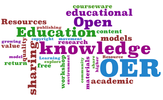OER4Ed Why OER?
OER or How to engage learners and educators without reinventing the wheel
Reflection
Given the plethora of information which you can easily access on the Internet, consider the following:
- How and why is an OER special?
- Why should you take the time to find or create an OER for use with your students?
- Why should you encourage your students to use or create OER?
|
The aim of OER is to improve access to learning opportunities by sharing knowledge and learning resources. If you join this international community of educators you can;
- save time,
- cut costs
- and contribute to improving the quality of learning in your own classroom and around the world.
The OER movement and community seeks to stimulate, facilitate and increase the growth of the pool of learning resources freely available on the Internet. With OER you are free to use, adapt, mix and share the resources, and become part of this growing community.
Using OER is simple and rewarding!
Key points
Remember the 4Rs of OER:
- Reuse - Use the work verbatim (unaltered), without having to ask permission.
- Revise - Alter or transform the work to meet your needs
- Remix - Combine the (verbatim or altered) work with other works for enhanced effect
- Redistribute - Share the verbatim, reworked, or remixed work with others.
(Wiley, 2007)
|
Each of these things can be done with traditionally copyrighted material, but requires more effort and resources.
The value or benefits for learners
| “
|
- able to customize their learning experiences with the flexibility OER offer;
- access to the work of leading institutions and world renowned researchers and teachers;
- seeing/applying knowledge in a wider context than their course would otherwise allow ( e.g. international dimension);
- freedom of access (e.g. at work/home/on placement) and enhanced opportunities for learning;
- enable and support learner-centered, self-directed, peer-to-peer and social/informal learning approaches;
- the opportunity to test out course materials before enrolling – and compare with other similar courses.
Extract from Open Educational Resources InfoKit part Stakeholders and Benefits
|
”
|
| “
|
- supports collaborative learning;
- supports development of student content within and outside formal learning;
- easily accessed through student-owned technologies;
- increased access for non-traditional learners (widening participation);
- likely to encourage self-regulated and independent learning;
- likely to encourage peer support and mentorship.
Extract from Good intentions: improving the evidence base in support of sharing learning materials
|
”
|
The value or benefits for educators
| “
|
- student/user feedback and open peer review;
- reputational benefits, recognition;
- benefits (efficiency and cultural) of collaborative approaches to teaching/learning;
- availability of quality peer reviewed material to enhance curriculum;
- collaborative approaches to teaching/learning (CoPs);
- professional/peer-to-peer learning about the processes of OER release.
Extract from Open Educational Resources InfoKit part Stakeholders and Benefits
|
”
|
| “
|
- supports ease of access through search engines such as Google;
- supports sharing of knowledge and teaching practice;
- encourages improvement in teaching practice;
- supports immediate one-off instances of sharing;
- encourages multidisciplinary collaboration and sharing;
- increased transparency and quality of learning materials;
- easily incorporated with institutionally-owned technologies;
- promotes the concept of lifelong learning;
- encourages innovation and experimentation;
- supports effective retrieval through professionally created metadata;
- supports the sharing and re-use of complex learning resources.
Extract from Good intentions: improving the evidence base in support of sharing learning materials
|
”
|
Notes
This workshop is a good example of using OER:
- All the images have been sourced or adapted from existing images whose license is compatible with the Workshop's license (CC-BY-SA);
- Content has been sourced and remixed from other Wikieducator pages or available OER.
This would not have been possible without remixable resources (text and images), and the free software used to combine them.



